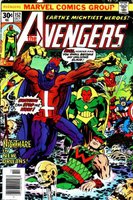 Okay, this past week I picked up some old Avengers comics from the mid-1970s. Steve Englehart and John Buscema. Talk about your classic material! And as I was sitting there reading through them, it really struck home why this stuff was so "classic" compared to what I'm reading today.
Okay, this past week I picked up some old Avengers comics from the mid-1970s. Steve Englehart and John Buscema. Talk about your classic material! And as I was sitting there reading through them, it really struck home why this stuff was so "classic" compared to what I'm reading today.Sure, there's a nostalgia factor involved. ("They don't make 'em like they used to!") But there were certain elements that were a given in each story. For example, I was starting in the middle of some story arc, but there was sufficient synopsis and character identification that I was quickly able to pick up and run with it. There was no need for a full-page text explanation of what happened the past two or three dozen issues; everything I needed was in the story itself. Similarly, the end of the story provided some sense of closure. Yes, there was a cliff-hanger ending to entice the reader to pick up the next issue, but the main questions and plot points addressed at the start of the issue were resolved by the end of it. And, ultimately, those things made for a very satisfying read.
(Of course, gorgerous John Buscema art never hurt anyone either!)
Now your typical response to these types of notices is that the market today doesn't support serial story-telling the way it used to. Readers are more likely to "wait for the trade" and get one longer story without these definitive 22 page chapters all the way through it.
There's certainly a degree of truth there. Trade paperbacks have become much more popular in recent years, and the more traditional periodical format less so. But here's where we run into problems. The serial comic requires a certain format. You've got 22 pages to tell a whole, or part of, a story every month. That should include whatever information is necessary for a new reader to pick up and start running with it. To some degree, "writing for the trade" follows a similar format, but the main story is more self-contained and character introduction and definition are drawn out over the entire story. Which is fine if you're reading it in a trade paperback format, but it doesn't work in the monthly, serialized format because you've got arbitrary story breaks in what's otherwise treated as a continuous narrative.
I don't have a problem if writers want to "write for the trade" but it seems to me that if they're going to do so, then the results should be published as a trade and not as a serial. Ever try reading Edgar Rice Burroughs? Tarzan and John Carter? They don't work as single novels because they were written as serials. Which means that the protagonists are up against an impossible challenge at the end of every chapter. Likewise, taking a longer format -- say, a two hour movie -- and serializing it -- say, into a series of twenty minute TV episodes aired once a week -- doesn't work.
There are strengths and weaknesses to any format of fiction. I just think that writers and artists should work towards the strengths of the format they're primarily working in, and editors should not force one format into another.






0 comments:
Post a Comment